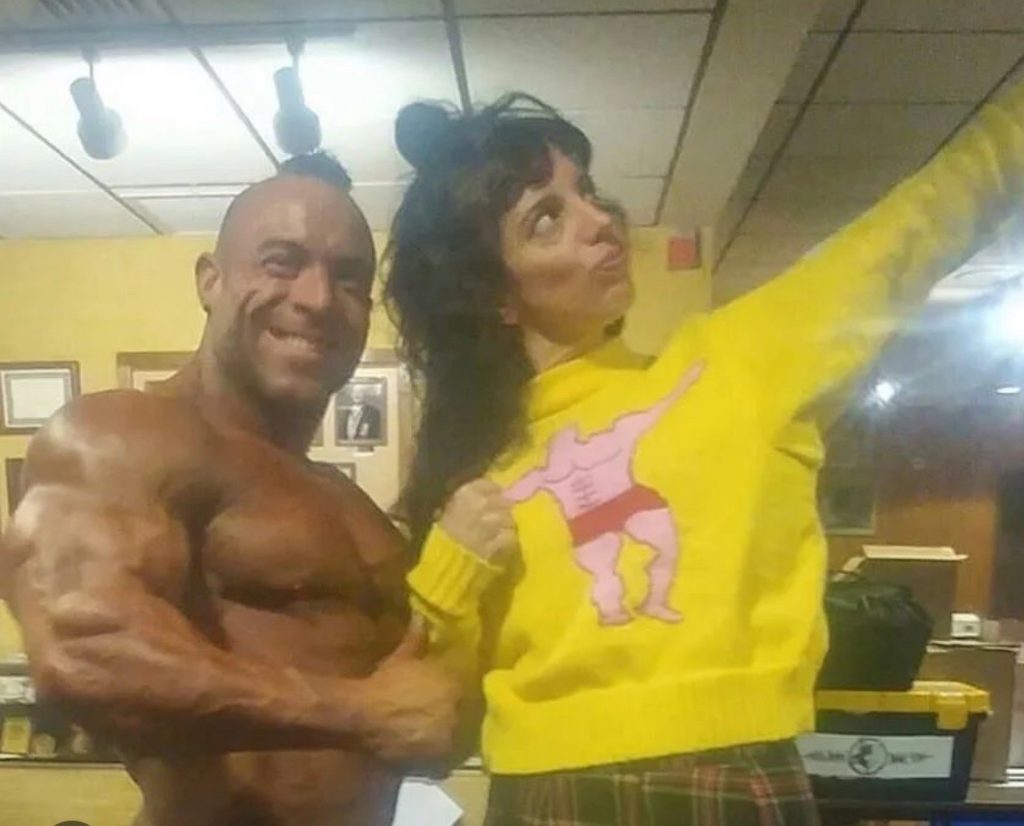WIP Artist Highlight: Madison Berg
Walking into Madison Berg’s studio, the first thing that catches my eyes is a bright yellow sweater with a bodybuilder on it. Her yarns all line up the shelves of the studio, her pieces speak in color as well. She tells me that she had a time where she was obsessed with bodybuilders.
“They symbolize a sense of obsession, and this is what I ended up with my fascination towards them.”

Bodybuilders aside, though, we dive into more serious talk.
Madison says she started getting into textiles in 2013, mostly with embroidery and hand-knitting.
“It shifted when I went to Central Russia in 2015, and I saw that the people there had devoted a good part of their life to textiles. The relationship to textiles there felt much more second nature. So from there, I got further into sewing, and various aspects of performance art, puppetry. I consider myself a crafter.”
She touches on expanding her work, further than something of utility and focusing on visual pieces, such as a tapestry she’s working on.
I ask her about her identity as a crafter, and what comes along with that focused term of craft.
She touches on the highbrow nature of fine art, compared to folk art, and more so, the lack of desire to look at traditional gallery spaces.
“I taught myself to knit, most of my yarn is found or donated, so my life meshes with a more DIY style of art. Without the pressures of gallery representation, I feel a lot more free to do whatever it is I want to do.”
With craft, there is textile. And so the question arises: why textiles?
“When I first moved here from the Midwest, textiles were a very immediate outlet to spend time. Growing up, textile practices at home or within family came from a sense of necessity, and not as much as a craft to do. So this is my way of shifting and redefining the realm for myself.”
Naturally, from medium, we move to themes and inspirations that Madison is drawn to.
“I find everything in life is just chaos, and I just want to capture the subversive and absurd cultures of it. I also draw a lot of imagery from folk art, regarding the earth and nature, so that makes its way into my work as well.”
She points to the drawing for a tapestry she’s working on now. There are eggs at the bottom, leading into a frog. A crow on a tree.

“An image of death”, she says.
“I find that this entire life cycle points to so much existentialism, and so this entire drawing deals more so with death.”
By contrast, we go back to the bodybuilder sweater. Contrast, on the basis of a tapestry versus a sweater, yet also the states of life and understanding the influences. She tells me that the sweater and the imagery present a very particular stage of her life, where one theme makes up the major influence of work. The culmination of that influence is the work she produces out of it.
She also goes into the lack of pressure of sticking to certain influences and mediums.
“I think I go based on what exactly I’m feeling at the moment. Because I find that’s what craft is truly about. And I think that goes for mediums as well, like if I want to stop machine knitting and move into a different medium, I want to wholeheartedly feel that.”
We move into the subversive nature of textile and what she aims to do with a shocking quality in her own medium.
“I find textiles to have a bit more of a soft nature, compared to maybe painting, as an example. So I find that I like to find that any more shocking elements towards textiles, be it themes or technicalities, can flip the understanding of the medium on its head.”

Speaking of technicalities, I ask her about certain technical practices she’s drawn to.
“I draw all my pictures in the beginning, all by hand, but from there I’m setting up the machine yarn by yarn, section by section. With the machine, it’s faster than hand knitting, but I find them to be separate outlets. For hand knitting, I work on more classic pieces that feel very long term, whereas the machine is an immediate outlet to make something really based on what I’m thinking about.”
We jump into teaching, considering Madison’s experience with both teaching and repairing machines.
“I mostly teach beginner knitting, and it’s a learning experience for me to understand how others can make mistakes and learn through the process. But overall, it makes me have an appreciation to pass on this knowledge of craft, and give good jumping off points for my students to further explore knitting, in whatever capacity they do.”
There is a documentation facet in teaching, in that the progression of knowledge is so tangible in the relationship between teacher and student. But I’m curious about Madison’s own documentation process, and what kinds of forms that takes.
“I always have so many notebooks just documenting the steps, patterns, and specificities, so I find that to be a continual element of my process. But for the most part, I am very focused on the moment to moment basis of my craft, so I find that there’s a more developing relationship with documentation.”

As we near the end of conversation, I ask her about new projects, influences, or mediums she’s looking to explore.
“I’m really looking forward to more tapestries that are knitted, like the project that I’m working on right now. But I’ll just have to see what comes about in the new year. And even then, I always leave the possibility on the table that I may just move on from knitting into something completely new. We’ll just have to see what path comes up. That’s all the fun.”